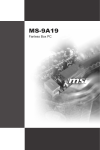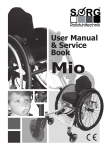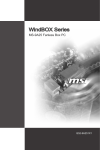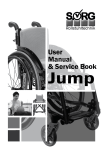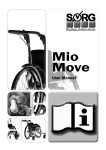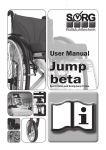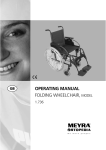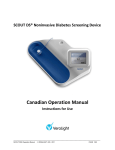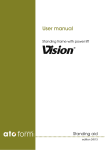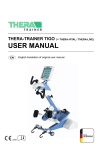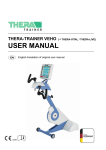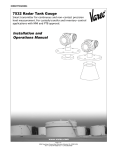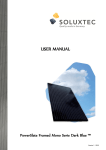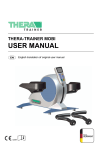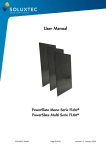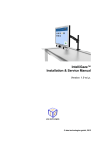Download PDF user manual - SORG Rollstuhltechnik
Transcript
User Manual & Servic Book Tilty vario Page 2 of 58 User Manual Tilty vario We are a company-member of rehaKind e.V. International Support Group for the Rehabilitation of Children and Adolescents Imprint: Technical collaborator: Manfred Ball Editing and layout: Bernhard Wendel As at 05/2012 Technical alterations and misprints excepted. V.i.S.d.P. SORG Rollstuhltechnik GmbH + Co.KG Bernhard Wendel Benzstraße 3-5 68794 Oberhausen-Rheinhausen Fon 07254 - 9279.0 Fax 07254 - 9279.10 Mail [email protected] Web www.sorgrollstuhltechnik.de © by SORG Rollstuhltechnik GmbH + Co.KG Benzstraße 3-5, 68794 Oberhausen-Rheinhausen. All texts and pictures are subject to copyright and may not be published - not even in extracts! without the explicit authorisation of SORG Rollstuhltechnik Gmbh + Co. KG. User Manual Tilty vario Table of Contents 1. General References ........................... 4 1.1 Preamble ............................................... 4 1.2 Reception .............................................. 4 1.3 Specifications ....................................... 5 1.4 Application ............................................ 6 1.5 Accessory and attachment drives ..... 6 2. Safety Instructions ............................. 7 2.1 General Security Advice ...................... 7 2.2 Before Every Use .................................. 7 2.3. How to Avoid Tipping .......................... 8 2.4 Coping with Obstacles ......................... 9 2.5 Heat & Water ........................................ 9 2.6 Driving in Road Traffic ......................... 9 3. Adjustments .....................................10 3.1 Leg Support Adjustments ................. 10 3.1.1 Undivided Leg Support .............. 10 3.1.2. Hinged Leg Support (optional) . 11 3.1.3. Leg Support with Support Pad (optional) ............................................. 13 3.2 Seat Heights........................................ 14 3.3 Centre of Gravity................................. 15 3.4 Back Height ......................................... 16 3.5 Back Extension with Head Pad (optional) ..................................................................... 17 3.6 Pelvic Belt (optional) .......................... 17 3.7 Back Angle .......................................... 18 3.8 Side guard, clothing guard................ 19 3.9 Arm Pads (optional) ........................... 20 3.10 Adjustment of Caster and Rear Wheel ..................................................................... 20 3.11 Locking brake ................................... 21 3.11.1 Standard Knee-lever Brake .... 21 3.11.2 Drum Brake (optional) ............ 22 3.12 Anti-tippers ....................................... 22 3.12.1 Anti-tipper (opt.) ...................... 23 3.13 Head Rest (optional) ....................... 24 3.14 Lateral Truss Pads (optional) ......... 24 3.15 Abduction Wedge (optional) .......... 24 3.16 Push Handles ................................... 25 3.16.1 Extendable Push Handles (optional) ............................................................. 26 3.16.2 Push Bar (optional) ................. 27 3.16.3 Push Bar for up to 30 cm SW (optional) ............................................. 27 3.17 Growth Adaption (opt.) .................... 28 3.17.1 Seat Depth Extension ............. 28 3.17.2. Seat Width Adjustment .......... 29 Page 3 of 58 4 General Handling .............................. 30 4.1 Getting in and out .............................. 30 4.2 Push Handles ...................................... 31 4.2 Push Handles ...................................... 31 4.2.1 Push Bar (optional) ....................32 4.3 Tilt, Back Angle Adjustment and Extension .................................................... 33 4.3.1 Tilt ...............................................33 4.3.2 Back Angle Adjustment ..............34 4.3.3 Folding the Back to the Front ....34 4.4 Anti-tipper ......................................35 4.5 Wheels with Quick-release-axles ..... 36 4.6 Leg Supports ....................................... 37 4.6.1 Leg Support ................................37 4.6.2 Leg Support, Hinged (optional) .37 4.7 Locking Brake ..................................... 38 4.7.1 Locking Brake, standard ...........38 4.7.2 Attendant Brake (optional) ........38 4.7.3 Drum Brakes (optional) .............38 4.8 Loading and Transportation ............. 39 4.9 Safety of Transportation ................... 39 4.10 Transportation of a wheelchair as Seat in a Passenger Car........................... 40 5 Maintenance ...................................... 41 5.1 Cleaning and Attendance ................. 41 5.2 Disinfection ......................................... 41 5.3 Inspection ............................................ 42 5.4 Checklist and Maintenance .............. 43 5.5 Checklist Yearly Inspection .............. 45 5.6 Reparations......................................... 46 5.7 Service ................................................. 46 5.8 Replacement Parts ............................ 46 5.9 Disposal ............................................... 46 5.10 Reuse ................................................. 46 5.11 Tyre Change ...................................... 47 6 Technical Data ................................... 48 6.1 Measures and Dimensions ............... 48 6.2 Meaning of Labels .........................49 7 Warranty ............................................ 50 e.g. for constructional changes etc.8 Warranty Form ...................................... 53 8 Warranty Form .................................. 54 9 Life Cycle Record ............................... 55 9.1 User Chronology ................................. 55 9.2 Service Book ....................................... 56 Retailer Information ............................. 58 Page 4 of 58 1. General References 1.1 Preamble Tilty vario will be your child’s reliable companion in their everyday life. For this purpose, your child has to familiarise with the wheelchair because, as any other technical device, it may hold manifold dangers if used inappropriately. The following user manual is divided up into 5 function-specific chapters: 1. Preamble, 2. Safety Instructions, 3. Adjustments, 4. General Handling, 5. Maintenance. Chapters 6-8 discuss technical data and warranty conditions. Chapters 2 and 4 are supposed to acquaint you and your child with the wheelchair and to explain its daily handling. Chapter 3 is directed EXCLUSIVELY to your rehabilitation engineer since this chapter deals unexceptionally with safety-relevant points. So please, in your own interest, leave the adjustment work to a qualified medical supply store. Looking back on our long-standing experience as one of the leading manufacturers in childhood rehabilitation, we work most carefully and thoroughly during all stages of development and construction. This enables us to guarantee you the highest standard of quality, individuality and safety. Through our certification according to ISO 9001:2008 we commit ourselves to continuously extending this quality standard. All materials used for the wheelchair are flame-resistant. For reasons of simplification, in the following chapters we will only refer to you; however the information given is all the more vital for your child since it contains important safety instructions. ATTENTION As the current owner of the wheelchair, please keep this manual in a safe place and make sure all work done on your wheelchair by your medical supply store is documented in detail in the respective chapter at the end of this manual. In case of a reuse of the wheelchair, this manual serves as an important source of information for your health insurance fund. Additionally, it provides the verification of regular inspections, which might be important in the event of a warranty claim. User Manual Tilty vario Therefore, please keep this manual with the wheelchair and hand it back to your health insurance in case of return of your Tilty vario. PLEASE NOTE This user manual is intended for both you and your rehabilitation engineer. It contains instructions on the correct adjustment of the medical aid which may exclusively be conducted by a qualified member of the specialised trade (cf. chapter 3). Moreover, it is supposed to help you get acquainted with the handling of your new Tilty vario and to avoid accidents (cf. chapter 4). This manual covers all possible equipment options that might be installed on a Tilty vario and thus may contain chapters that do not conform to your particular configuration. ATTENTION Please read and mind this user manual with its general safety instructions carefully before putting Tilty vario into service for the first time. If you have any questions, the sanitary trade of your confidence or our competent team will be glad to help you. Service line +49 07254 / 9279-0 We appreciate your trust! 1.2 Reception Each SORG wheelchair is mounted and tested for functional efficiency and freedom from defects by our specialists and is then packaged in special paperboard containers by our shipping experts. Thus every SORG wheelchair leaves our factory in a flawless condition. The wheelchair has been constructed according to your ordering information; the technical factory delivers your wheelchair ready for use and adjusted to your needs. PLEASE NOTE For judicial reasons, we nevertheless need to ask you to check your wheelchair IMMEDIATELY after reception and in the presence of the bearer for any damage that might have occurred during transport. Please note that, according to the legal situation, belatedly recorded damage cannot be asserted, neither to the forwarding company nor to us! User Manual Tilty vario Please do not sign the acknowledgement of receipt of the forwarding company before careful inspection. The necessary steps and measures for individual adjustments are stated in chapter 3 “Adjustments”. ATTENTION For safety reasons, all adjustments described are to be conducted exclusively by a specialised trade member qualified for this purpose. PLEASE NOTE For ecological reasons, we kindly ask you to keep the packaging in case transportation becomes necessary at a later point. 1.3 Specifications Tilty vario is a compact tiltable children's wheelchair with a rigid frame and firm wheel base. The entire seat-back-unit is tiltable by 27° via the gas pressure spring, and the back angle may be adjusted by 40° backwards or folded frontwards. Thanks to its light weight, its outstanding handling characteristics, as well as the custom-fit adjustment options of the ergonomically ideal grip point, Tilty vario may also be used as an activity wheelchair. Tilty vario is indexed for children with a seat width from 28 cm (approx. 11 in) and a weight load of up to 90 kg (approx. 198 lbs). It supports early and careful activation. The tilting and back angle adjustment contribute to shifting strains and thus to training the entire tonicity as well as stimulating the cardiovascular system, the metabolism and digestive tract. An upright position of the pelvis and a good decubitus-prophylaxis are being supported. Tilty vario aids in developing reflex control and perception, prevents scolitotic processes and supports the development of controlled muscular tonicity. These possibilities conform to the following disease patterns: Spinal muscle atrophy Spina Bifida Craniocerebral injury Cerebral palsies Page 5 of 58 All forms of paraplegia Infantile cerebral palsy (ICP) Paralysis Athetosis Ataxia Unstable circulation and metabolism Risk of decubitus Difficulties in obtaining/maintaining an upright position Pathological pattern of movement Distorition of perception Asymmetries Lack of body and head control From SW 28 cm and up to a maximum payload of 90 kg, there are 2 different frame sizes available; frame size 1 (SD 30-34), frame size 2 (SD 36-40). Page 6 of 58 Tilty vario is not suitable for use in the following cases: Tonicity disregulation (hyper- and hypotonicity) Epilepsy/spasticities Inability to be seated The intended maximum payload must not be exceeded. 1.4 Application Tilty vario is suitable for both indoor and outdoor use. It is designed exclusively for the walking impaired or abatic child or adolescent to whom the wheelchair has been adjusted by a qualified specialist, for individual use in selftransportation or transportation with an assistant. ATTENTION The transportation of a person may only be conducted on solid surface and using a seat unit or a seat shell. The wheelchair does not serve as a means of transportation for goods or the like. It is not intended to be used as a seat in a motor vehicle. 1.5 Accessory and attachment drives Accessory or attachment drives may only be mounted on models which we have released for this purpose. ATTENTION The mounting of additional drives is to be conducted by the producer of the respective system or by the medical supply store charged with this purpose - and entirely on their responsibility. User Manual Tilty vario User Manual Tilty vario 2. Safety Instructions 2.1 General Security Advice Please make sure to read this user manual and the safety instructions very carefully before taking your new Tilty vario into service. It is of utmost importance that both the user and the assistant are able to both understand and realise all instructions. Since it is not possible to list all dangers that may possibly occur under different circumstances, please make good use of caution and mind whenever you are using your wheelchair! Please use Tilty vario exclusively according to the specifications described in chapters 1.3 and 1.4. If used otherwise and/or inappropriately, the wheelchair may endanger you and your surroundings considerably. Furthermore, this may lead to the expiry of our guarantee and product liability! Please make yourself and your child acquainted with the respective functions, specific characteristics, and the operation of your wheelchair. Take sufficient time for this and please make sure to conduct your first driving practices with the support of an experienced assistant. It is very important that – in the presence of an experienced assistant – you test the stability of your new wheelchair to both sides, to the front, and to the back. To do this, please slowly lean as far as you can to each side, front, and back while sitting in your wheelchair in order to, for instance, pick up an object from the ground. Attentively observe when exactly the wheelchair starts tipping over and memorize this point well. Page 7 of 58 and your surroundings considerably. Always position your wheelchair against a wall or a corner so it cannot roll away. Please do not by any means conduct adjustments, maintenance and/or repair work by yourself, but always turn to the medical supply store of your confidence whose trained staff has been introduced proficiently to the conduction of this work and is equipped with the necessary tools. For functional reasons, your hands are placed on rotating parts (i.e. the rear wheels) while driving your wheelchair. To avoid injuring your hands, please make sure not to reach into the spokes of the rear wheels or the space between rear wheel and lever brake. Profile wheels with integrated handrims or spoke covers (optional devices) reduce the risk of finger injuries. 2.2 Before Every Use The functional efficiency of the locking brake (cable brake and attendant brake) is dependent on: • correct inflation pressure • intact bowden wire • non-worn-out braking bolts Please check the braking effect of the cable brake before every use. The cable brake can only function properly with sufficient air pressure and flawless tyre profile of the rear wheels. Check the cables of the cable brakes for damages before every use. Damaged cables are to be exchanged immediately. Check the correct tyre inflation pressure according to the indication on the tyre equipment. By the way: it will be a lot easier to drive and manoeuvre your wheelchair with the correct air pressure of caster and rear wheels. To keep your wheelchair permanently safe and functional, please consider the instructions on handling (chapter 4) and maintenance (chapter 5). Please check the safe and firm fit of the quickrelease-axles: If the quick-release-axle button is not pressed, the rear wheels or casters must not be removable. The axles need to be cleaned from dust and fluff regularly. Do not ever leave your wheelchair unattended – neither empty nor occupied! The brakes might loosen unintentionally and endanger you, your child, Please conduct a general visual inspection to duly discover and repair possible damage that might lead to endangerment. Page 8 of 58 2.3. How to Avoid Tipping Avoid using the foot rest when getting in or out of your wheelchair for it might tip forward. If possible, please fold the foot rest to the side or to the back in order to get closer to the wheelchair. And make sure that you only conduct this action on firm, even ground and with the locking brake tightened. Under certain circumstances it might be therapeutically necessary that the child does use the foot rest to get in or out of the wheelchair. In this case, please turn the rear wheels forward to improve the wheelchair’s resistance against tipping and do not let your child get in or out without supervision and assistance. At first, practice all driving techniques on even ground and only with the support of an experienced assistant. Only after that should you try and tackle downgrade and upgrade paths – again, with the support of an experienced assistant. Avoid putting your wheelchair into bank positions on uneven or sloping ground to prevent it from tipping sidewards! Always drive in right angle from the hillside/the obstacle, never diagonally. Please avoid extreme adjustments of your wheelchair with a high seat inclination and place the seat back as far at the front as possible to gain safety from tipping. Extreme configurations combined with a disadvantageous posture may provoke the wheelchair to tip, even on level ground. Please drive downgrade or upgrade paths exclusively with the anti-tipper feature activated. When driving on upgrade paths and offsets, bend the upper part of your body forward as far as possible and drive ramps and upgrades with a pitch or incline of more than 7% (4°) only with the support of an assistant. When driving downgrade paths, please bend your upper body as much to the back as possible. Adjusting the casters incorrectly or driving too fast (especially on downgrade paths) may lead the casters to judder, which may result in a dangerous and abrupt braking of the wheelchair. Hence, do not change the pre-adjusted position of the casters in the caster fork, drive downgrade paths very slowly User Manual Tilty vario and bend the upper part of your body backwards while doing so. In order to reach for objects on the sides or in front of your wheelchair, please remember your initial stability test and do not lean out too far. If you feel insecure, you may use a reacher. ATTENTION The locking brake cannot usually be used to brake during driving since this might make your wheelchair halt abruptly with the risk of falling out for the passenger. It is only to be used in that way very limitedly and only by very experienced drivers. We strongly recommend using anti-tippers to inexperienced and young wheelchair drivers. Depending on the body measurements specific to the user, it might be possible that adjustments of seat and wheel positions beyond the tipping safety limits can be realised on your wheelchair. In this case, the safety from tipping must be valued over the handling characteristics! User Manual Tilty vario 2.4 Coping with Obstacles To surmount level differences ramps or lifts should be used whenever possible. We strongly advise you to surmount stairs only with the aid of two experienced assistants. For this purpose, the safety wheel needs to be deactivated. Please mind that the wheelchair may be held, carried or lifted only on metal parts which are firmly bolted to the frame. Do not use escalators in any case – not even with assistants!!! Department stores and public buildings with escalators should always have suitable lifts available. Do not rapidly drive towards offsets (e.g. kerb stone edges) as this entails an increased danger of tipping! Do not jump from stairs or offsets with your wheelchair! This does not conform to the intended usage of the wheelchair, puts you and your surroundings in serious danger, and may damage your wheelchair heavily. Please remember to fold your anti-tippers to the inside while using lifts and lifting plates and while surmounting offsets. Before pulling a person seated in a wheelchair backwards over an obstacle via the push handles, please check the push handles in their bracket and the rubber pads on the push handle pipes for firm fit. 2.5 Heat & Water Handrims heat up through strong friction, especially by braking during fast driving or along downgrade paths. Therefore, if you have sensitive skin, we recommend you to wear gloves like those used in race-cycling (with leather palm protection – but never woollen gloves) or special wheelchair gloves. Page 9 of 58 Using the wheelchair in damp locations or in water should be avoided as this may lead to the corrosion of components, which, in turn, affects the driving quality and service life of your wheelchair negatively. ATTENTION Textile components of the wheelchair, such as cushion or plastic are inflammable. Therefore, please keep any ignition sources, particularly lighted cigarettes, away from the wheelchair. ATTENTION Exposed to direct solar radiation, dark surfaces of the wheelchair (seat, back, clothing guards, etc.) may heat up strongly. To avoid burns, place the wheelchair in a shady place or protect it from direct solar radiation with a blanket (or a similar object). 2.6 Driving in Road Traffic Keep in mind that as a driver/passenger in your wheelchair you are a “participant in public traffic” and therefore have to respect the road traffic regulations. Since your wheelchair does not count as a motor vehicle according to legal regulations, you may use pavements if you are driving at walking pace. In the dark, wear light-coloured clothes or clothes with reflectors whenever possible. Avoid driving on road surface or bicycle paths. Your wheelchair is provided with reflectors on the sides and on the back. Check regularly whether they are clean and clearly visible. To use your wheelchair as a seat in a passenger car, only use means of transportation approved for the transportation of wheelchairs. Transporting a person sitting in a wheelchair in a vehicle entails a considerable safety risk for all people involved. We therefore strongly recommend not using the wheelchair as a Page 10 of 58 seat in a passenger car and sitting down on a conventional car seat instead. During a ride in a vehicle (including public transport), you must not be seated in your wheelchair without a restraint system for a passenger. ATTENTION If using your wheelchair as a passenger seat in a vehicle cannot be avoided, the regulations according to DIN 75078-2 have to be fulfilled! Please make sure to read chapter 4.10 “Transportation in a passenger car”! 3. Adjustments The following indications on the adjustments of Tilty vario affect its usage safety! Therefore, we are pointing out explicitly that all adjustments, reparations, and any other sorts of changes are to be conducted exclusively by the rehab technicians of your medical supply store who have been qualified by us! The instructions relevant for you and the daily handling of your wheelchair are described in chapter 4 “General Handling”. If no other specifications are indicated, the following torques are valid for screw joints: M5: 5 Nm M6: 7 Nm M8: 20 Nm M10 (si-nut): 25 Nm (caster) quick-release-axle fitting: 35 Nm User Manual Tilty vario Otherwise, you may endanger yourself, your surroundings, and especially children considerably, and, moreover, lose our warranty claim! ATTENTION When conducting any adjustments, please make sure to maintain distances between all movable parts (e.g. truss pads, abduction wedge, etc.) and fixed parts in order to prevent human body parts from clamping in between them. Guidance values for this purpose are: Finger area: <5 mm or >25 mm Foot area: <25 mm or >45 mm Head area: <60 mm or >250 mm 3.1 Leg Support Adjustments 3.1.1 Undivided Leg Support The leg support is ideally adjusted if the complete thigh rests (with a two finger distance between seat and hollow of knee) evenly on the seat cushion/shells while the leg is standing A on the foot rest in a right angle. A foot rest positioned too high leads to a permanently buckled position in the pelvic area. If it is adjusted too low, unpleasant congestions in the thighs might occur. ATTENTION A wheelchair is a medical aid which must be adjusted to the individual situation of your child by your rehab technician in order to obtain the highest therapeutic benefit possible. But every technical device inherits safety risks in everyday usage. Therefore, we are pointing out Pos 1 explicitly that all adjustments, reparations, and any other sorts of changes are to be conducted exclusively by the rehab technicians of your medical supply store who have been qualified by ATTENTION Please make sure not to use the Pos 2 us! leg support to get in or out of the wheelchair in order to avoid the danger of tipping! User Manual Tilty vario Adjustment of the lower leg length loosen screws (pos. 2) on both sides choose desired position, tighten screws (pos. 2) tighten screws (pos. 2), making sure that the foot rest can still be hinged upwards Adjustment of the depth loosen screws (pos. 1) place leg support bracket into desired position retighten screws Page 11 of 58 Adjustment of the depth is conducted on the fixation below the seat plate (pos. 1). Adjustment of the lower leg length loosen screws (pos. 2) on both sides choose desired position on the axle plate tighten screws (pos. 2) firmly to hinge, loosen locking bolt (pos. 3) on both sides and let it snap into the desired hole Adjustment of the angle ATTENTION By changing the distance between the footrest and the carrier pipes (pos. 1), you may change the angle of the footrest by ± 10°. Screw pos. 1 to the desired lenght,... . Locking device (optional) pull out the spring bolts (A) on both sides, then turn the spring bolt by 90° hinge footrest backwards again, turn both spring bolts by 90° until they engage into the slot to open the interlock, please proceed analogically ATTENTION Do not start your ride until you have made sure that the spring bolt is engaged firmly! ATTENTION Please make sure not to lean too far out of the wheelchair when (un-)locking your footrest for you may fall out! Please have someone assist you. 3.1.2. Hinged Leg Support (optional) The hinged leg support is available in one piece or divided: The leg supports can be altered in their angles up to a horizontal position (180°). This way the legs can be elevated in the tilted seat position to improve blood circulation. Pos.1 A Page 12 of 58 User Manual Tilty vario Pos.3 Pos.1 Pos.2 User Manual Tilty vario Page 13 of 58 3.1.3. Leg Support with Support Pad (optional) If you choose a leg support with support pad, the opposite side is supplemented with a divided swing-up leg support. The side with the pad does not have a foot rest! Adjustment of the support pad loosen the clamping lever (pos. 1) on the lower side of the pad choose desired position on the axle plate (A) tighten clamping lever (pos. 1) firmly 1 Swinging up the leg support loosen clamping lever (pos. 2) place leg support into desired position tighten clamping lever (pos. 2) firmly Angle adjustment of the support pad loosen screw joint (B) adjust desired angle tighten screw joint 2 A ATTENTION Please make sure to turn away the grip parts of the clamping levers (pos. 2) backwards so they cannot injure or inhibit your child. PLEASE NOTE If your wheelchair is equipped with a support pad on both sides, please conduct adjustments analogically. B 1 Page 14 of 58 User Manual Tilty vario 3.2 Seat Heights Usually, the seat height at the back is adjusted to be approx. 2-3 cm (0.8-1.2 in) lower than at the front in order to obtain a secure and comfortable sitting position with even distribution of the seat pressure and to straighten up the pelvis. (Differing adjustments may also make sense in individual cases.) In the case of Tilty vario, the entire seat unit may be altered via the gas pressure spring (there is no other option for this purpose). Therefore the best way to obtain the desired seat inclination is by using the tilting mechanism. ATTENTION When adjusting the seat height on the front, you should always make sure that you can access tables easily without your knees hitting their edges. Corresponding to the position of the foot rest, the casters must be free to rotate 360°. Adjustment of the seat height By modifying the seat carrier plate, you may alter the seat height by up to 2.5 cm (1 in) differing from the height adjusted when the wheelchair is leaving our factory. remove screw joints (pos. 1) on the front and back completely mount seat carrier angle (pos. 2) into desired position retighten screw joints firmly Pos 2 Pos 1 User Manual Tilty vario Page 15 of 58 3.3 Centre of Gravity You may change the centre of gravity of the wheelchair (X) by moving the seat plate (pos. 2) in relation to the seat carrier part. When leaving our factory, the wheelchair is preadjusted into a tipping stable position. The further back the seat is mounted, the more the wheelchair tends to tip backwards. However, it may also be tilted back on 2 wheels more easily. This facilitates, for experienced wheelchair users, to quickly and easily surmount obstacles, as the wheelchair’s agility is effectively improved. ATTENTION Even if the anti-tipper is activated and there is actually no danger, a beginner may be unsettled or even demotivated if the wheelchair‟s adjustments make it too prone to tipping! ATTENTION Please work carefully, gradually, and only with the aid of an experienced assistant towards the maximum degree of tipping proneness desired for by the user! Read the SAFETY INSTRUCTIONS carefully (p. 7 2ff). loosen screws (pos. 1) and place seat (pos. 2) into desired position retighten screws firmly test new adjustments with the securing support of an assistant! X Page 16 of 58 User Manual Tilty vario 3.4 Back Height Height adjustment by 5 cm: remove screw joint (B) of the back pipes on the angle adjustment device place back pipes into desired position retighten screw joint B B PLEASE NOTE You can adjust the entire back angle adjustment device via the lower screws (A) in 2.5 cm steps. While doing so, however, please keep in mind that you are also altering the turning point of the back adjustment (which may be of advantage if e.g. a thicker cushion is being used). Height adjustment by 2.5 cm: loosen screw joint (A) on both sides pull out back and screw it onto new position make sure to insert the screws properly into their thread and to secure them with screw locks A A User Manual Tilty vario 3.5 Back Extension with Head Pad (optional) We strongly recommend this back extension in order to make sure your child is able to decide when they want to drive actively or rest. It provides the same comfort as a buggy and supports the head (white not inhibiting its movement) when the wheelchair is tilted. Activating and deactivating the back extension remove the head pad (A) loosen star knobs (pos. 1) on both sides pull up the back extension (be careful not to wedge the extension plate) tighten star knobs (pos. 1) firmly attach the head rest onto the other side with the aid of the Velcro strips provided 3.6 Pelvic Belt (optional) Mounting of the pelvic belt: Pull the free ends of the belt on both sides through the space between the side part and back adapter. Screw together the ears of the belt ends into two of the bolts on the back adapter. Screw the eyes of the belt ends onto the bottom cross-brace in between the frames. Page 17 of 58 A Page 18 of 58 User Manual Tilty vario 3.7 Back Angle Put the back into the desired position by pulling the string (A) on the ring on the back of the seat downwards until the locking bolts (B) unlock on both sides of the back angle plate. A Then, let go of the ring with the string and make sure that the locking bolts have snapped firmly into the bores of the back angle plate. For transportation, the back may be folded onto the seat and locked in that position. B User Manual Tilty vario Page 19 of 58 3.8 Side guard, clothing guard Tilty vario's side guards and clothing guards are pre-adjusted in relation to its wheel size. However, you may adjust the side guard and clothing guard in their sizes, independently from each other. For the side guard, the screw-inadapter (A; here in combination with the drum brake) must be loosened. Loosen screws (pos. 1) as well so the side guard can be placed 2.5 cm up or down. The clothing guard (B) can also be adjusted to the wheel size by loosening the screws (pos. 2). For both steps, please make sure that the screws are retightened firmly afterwards and that the gap between clothing guard and wheel coat is no more than 5 mm. Pos. 1 A The lever for the locking brake (if present) is integrated into the clothing guard. B Pos. 2 Page 20 of 58 User Manual Tilty vario 3.9 Arm Pads (optional) The arm pads, too, are firmly screwed onto the side guards so no further adjustments need to be done. You may adjust the height of the pads via a clamping screw on the retainer of each arm pad. 3.10 Adjustment of Caster and Rear Wheel When all adjustment work on the seat inclination has been done, it is important to readjust the inclination of the steering head because all changes of the centre of gravity, the wheel base, on the caster axle, etc. directly influence the inclination of the steering head. To adjust the caster adapter, please loosen both screws (A) which connect the adapter and the frame. Place the adapter into a perfectly vertical position by turning the adjusting washer (B) (with an Allen key size 4) - you may check this by taking an angle. Make sure to tighten all screws after finishing your adjustment work! A A B User Manual Tilty vario Page 21 of 58 3.11 Locking brake Each wheelchair is equipped with two knee-lever brakes. They are to be used EXCLUSIVELY to secure the wheels in a rest position. They are NOT designed to decelerate the wheelchair while driving. For this purpose, please use the handrims or, if provided, the drum brake. Please be aware that aliminuium-handrims may heat quickly due to friction. For your own safety, always check whether the brakes function correctly. Its function may be restrained by too little air pressure in the tyres, moisture, worn out profile, the brake cable having beenadjusted too weakly, and too much distance between the brake and the tyres. 3.11.1 Standard Knee-lever Brake First, please check the tyre air pressure of the rear wheels (the necessary indications are provided on the tyre cover) and inflate them if necessary. To adjust the brake, please loosen both screws (A) on both sides, put the brake into the respective position and retighten the screws (A) firmly. A ATTENTION Readjust the brakes after conducting any alterations on the rear wheels and check their functional efficiency and the tyre air pressure BEFORE every ride. On a ramp with 6% decline, the rear wheels of the wheelchair (with passenger) must not slip with the locking brake activated. A The distance between brake pressure bold and tyres is for Standard-KLB ca. 21 mm Pull-to-lock-brake 11 mm and KLB with recoil blocking system ca. 10 mm (technical alterations reserved) Tighten the screws firmly and check the functional efficiency as described above. Page 22 of 58 3.11.2 Drum Brake (optional) The drum brake is, unlike the locking brake, also suitable for braking while driving. The adjustment of the drum brake is to be carried out through a set screw (A) at the lower end of the brake cable. The brake is readjusted by turning the set screw counter-clockwise. In the second lock-in-position of the hand brake lever (B), the brake must be so tight that the rear wheels of the wheelchair with passenger will not slip on a ramp with 6% incline (cf. above). To lock firmly, the latch lever (C) has to snap into the brake lever (B). To unlock, please pull the brake lever further which will release the latch lever automatically. ATTENTION The brake shoes of the drum brake react very sensitively to dirt, fluff, etc. Please clean the brake regularly with a dry brush. When removing and inserting the wheels with the quick-releaseaxle, make sure not to damage the brake as this would be a considerable safety risk! User Manual Tilty vario remove screw joints (pos. 1) completely and insert them into suitable bores retighten screw joints according to instructions with the necessary turning moment check distance to the ground test function with securing support of an assistant When exchanging the springs (A), please proceed in the same manner. Further adjustments can be done via the small wheel at the back of the anti-tipper. loosen screws (pos. 2) on both sides remove screws (pos. 3) choose among the three holes and insert screws retighten all screws ATTENTION Make sure to make the same changes of the anti-tippers on both sides! 3.12 Anti-tippers The anti-tippers prevent your wheelchair from tipping backwards unintentionally. Correct adjustments are hence very important for the function of the anti-tipper. The correct distance to the ground is 2-5 cm. ATTENTION Please also read the respective chapters 2 of the SAFETY INSTRUCTIONS. Adjustment of distance to the ground measure current distance between the anti-tipper and the ground remove rear wheels A User Manual Tilty vario Page 23 of 58 3.12.1 Anti-tipper (opt.) A Please remove the rear wheels so you can reach the screws more easily. To adjust the anti-tipper in height, please remove both screws (A) and (B). Pull the entire console in the frame-retainer up or down by the desired extent. Now, move both screws (A) and (B) into the desired holes so that they are parallel. Tighten the screws firmly and check functional efficiency. Please note To exchange the spring, please proceed the same way. B C Retighten all screws firmly and make sure they will not loosen through vibration. A B 2 - 5 cm You may make adjustment in smaller steps via the small wheel at the end of the anti-tipper. For this purpose, please remove the axle (C), place the wheel-retainer into one of the three holes, and retighten all screws. Page 24 of 58 User Manual Tilty vario 3.13 Head Rest (optional) Our head rests may be adjusted in height, depth and angle. Loosen the clamping lever/set screw (A) by turning the joint that is to be adjusted a few times and retighten them after reaching the desired position. The angle adjustment of the head rest may be altered by slightly loosening the screw joint (B) and then reclamping it in the new position. B 3.14 Lateral Truss Pads (optional) If your Tilty vario is equipped with lateral truss pads, you may adjust them in vertical and horizontal position via the different bolts in the back pipe or moulded back. Loosen the screws (C), adjust the desired position, and retighten the screws. 3.15 Abduction Wedge (optional) The abduction wedge is supposed to keep the thighs apart. For children with too much tonicity in their legs this is often beneficial in order to obtain a better overall tonicity. For some children it is only then that the wheelchair becomes acceptable and usable. Depth adjustment loosen star knob (pos. 2) adjust desired position tighten screws firmly Height adjustment remove star knob screw joint completely adjust desired height retighten screws Avoid taking the wedge with the wedge adapter out of the guide pipe completely. C A User Manual Tilty vario 3.16 Push Handles We offer three options of pushing push Tilty vario: - extendable push handles (straight or angulated) - slide rod (only in combination with push handles) - push bars Please note To adjust the height or to remove, please proceed in the same way for all variants ATTENTION Before pulling a person sitting in a wheelchair over an obstacle with the aid of the push handles or push bar, please check if the handles are connected firmly to the wheelchair. The handles might loosen and thus cause considerable risk moments. Please also check whether the control lever and the set screw are connected firmly in order to avoid safety risks and to prevent losing the set screw. PLEASE NOTE When playing with other children, it is strongly recommend to remove the push handle, because the child might not able to anticipate the swivel radius and might thus involuntarily injure other children! ATTENTION Please also read the respective chapters 2 (p. 7 ff) on SAFETY INSTRUCTIONS. Page 25 of 58 Page 26 of 58 3.16.1 Extendable Push Handles (optional) User Manual Tilty vario A B To vary the height of the push handle, loosen the control lever. Make sure to tighten the clamping lever after adjusting in order to be able to handle the wheelchair reliably. ATTENTION Do not attach any bags or the like onto the handles, as this makes the wheelchair more prone to tipping. Adjusting the tension force To adjust the tension force of the fixation clamp, please put the clamping lever (A) into an open position, so it is set vertically on the clamping device. Regulate the clamping force of the clamping lever in relation to the retainer (B) via its thread. Close clamping lever. The push handle must not be movable in the closed position! Removing the push handles At the lower end of the aluminium pipe is a stand spring which prevents the push handle from slipping off the clamp while adjusting its height. Please open the fixation clamp. Push the safety button on the push handle down, keep it firmly in this position, and, simultaneously, pull the push handles out of the guide pipe. To insert the push handle, please open the fixation clamp again. Push the safety button and place the push handle, turned 90° counterclockwise, back into the adapter. About halfway through (you will feel a blocking), please turn the push handle back by 90° (clockwise), so the safety button can slip unimpeded through the clamp alongside the guiding slot. Finally, close the clamp and make sure that the push handles are attached perfectly firmly. User Manual Tilty vario Page 27 of 58 3.16.2 Push Bar (optional) The push bar is a pushing aid for an attending person and has been designed exclusively for that purpose! To adjust the height, please proceed as described above (A). To adjust the angle, please loosen the star knobs (B) on both sides, place the bar into the desired position with one hand, lock the one star knob with your free hand and then lock the other one. 3.16.3 Push Bar for up to 30 cm SW (optional) To adjust the height and to remove the push bar, please proceed as described in the previous chapters. To adjust the angle, push the buttons of both angle-adjustment-devices simultaneously and adjust the desired position. Please note Keep in mind that the swivel arm may influence Tilty vario‟s proneness to tipping. ATTENTION Do not attach any bags or the like onto the push bar, as the wheelchair might tip backwards due to the altered centre of gravity. The slide rod is a cross-linking bar between the push handles (described in chapter 3.16.1). Both ends provide a star knob to loosen the slide rod. It can be mounted supplementary. ATTENTION The slide rod is exclusively to be used to push. A tensile load must not be exercised under any circumstances. B A Page 28 of 58 User Manual Tilty vario 3.17 Growth Adaption (opt.) Tilty vario‟s back height is growth-adaptable by up to 5 cm (cf. chapter 3.4) without any additional parts. With the optional growthadaption-set, Tilty vario can also “grow” its seat depth and seat width by 4 cm each. 3.17.1 Seat Depth Extension remove screw joints (pos. 1) mount delivered seat extension with the delivered screws adjust desired extension and tighten screw joints Pos 1 User Manual Tilty vario Page 29 of 58 3.17.2. Seat Width Adjustment Loosen and/or remove all screw joints affecting the cross-link of the wheelchair: cross brace back and bottom cross brace front stabilising bar (opt.) seat plate (opt.) foot rest (opt.) all Velcros of seat and/or back clothing: Screw all cross braces into desired position, making sure they are screwed on symmetrically on the left and on the right. Restore all other links and screw joints and tighten them firmly. PLEASE NOTE The moulded back cannot be reused. It has to be exchanged corresponding to the new seat width. If you are mounting a new moulded back, please insert and knot the back angle adjustment device and slightly melt the ends of its string with a flame (pocket lighter) to prevent them from frazzling. cross-braces Page 30 of 58 4 General Handling The following indications on the operation of Tilty vario in everyday life are directed to you as a user of the wheelchair and are supposed to help you to use the individual functions of the technical parts safely, competently and conventionally so you can profit from your wheelchair for a long time. Please read the following indications on operation carefully and mind the suggestions on daily usage of your wheelchair. 4.1 Getting in and out When getting in or out, please make sure that the locking brakes are tightened. Have an assistant turn the casters forwards or drive backwards until the casters turn forwards; then close the locking brakes. This provides your wheelchair with extra safety from tipping when getting in or out. Please avoid stepping on the foot rest because that might make your wheelchair tip forwards. Do never lean on the clothing guard or the brake lever/-buttons inside the clothing guard when getting in or out for it may break. To get in or out, you best lean on the handrims with both hands or as centric on the seat as possible. Please familiarise yourself with the limits of your wheelchair right from the beginning by – essentially, in presence of an experienced assistant! – carefully leaning towards all directions and perhaps holding a heavy object with your outstretched hand and concentrating on the point where the wheelchair starts tipping. Please note that changes of the wheelchair‟s centre of gravity bring about different conditions. User Manual Tilty vario Familiarise yourself with them through appropriate tests – again, only in the presence of an assistant! In the long run, you can only prevent dangers that you are well aware of! User Manual Tilty vario Page 31 of 58 4.2 Push Handles We offer two options of pushing Tilty vario: - Extendable push handles - push bar (2 versions) ATTENTION Before pulling a person sitting in a wheelchair over an obstacle with the aid of the push handles or push bar, please check if the handles are connected firmly to the wheelchair. The handles might loosen and thus cause considerable risk moments. Please also check whether the control lever and the set screw are connected firmly to avoid safety risks and to prevent losing the set screw. C B offen geschlossen When playing with other children, it is strongly recommend to remove the push handle, because the child might not able to anticipate the swivel radius and might thus involuntarily injure other children! Adjusting the tension force: put clamping lever (A) into an open position , so it is set vertically on the clamping device regulate the distance between the clamping lever and the half-shell (C) via the set screw (B) you have reached the ideal point if the round end of the clamping lever (A) rests exactly inside the half-shell (C) close clamping lever The pushing handle must not be movable in closed position! PLEASE NOTE To adjust the height or remove, please proceed in the same way for all variants. To remove that push handles, push the stand spring at the end of the handle down with your finger and, at the same time, pull the push handle upwards until the stand spring is removed from its retainer. C A Page 32 of 58 User Manual Tilty vario 4.2.1 Push Bar (optional) The push bar is a pushing aid for an attending person and has been designed exclusively for that purpose! To adjust the height, please proceed as described above. To adjust the angle, push the buttons (A) of both angleadjustment-devices simultaneously and adjust the desired position. PLEASE NOTE Keep in mind that the swivel arm may influence Tilty vario's proneness to tipping. ATTENTION Do not attach any bags or the like on the push bar, as the wheelchair might tip backwards due to the altered centre of gravity. A User Manual Tilty vario Page 33 of 58 4.3 Tilt, Back Angle Adjustment and -Extension Tilty vario's entire seat unit may be tilted continuously by 25° using the gas pressure spring (image 1). Additionally, the back angle may be adjusted from 80° to 120° via the ratchet joint (image 2). image 1 ATTENTION Both adjustments strongly affect the centre of gravity and thus the proneness to tipping of the wheelchair! Familiarise yourself with Tilty vario's new tipping characteristics with the support of an experienced assistant! 4.3.1 Tilt To tilt Tilty vario, please activate the anti-tipper before working the release lever on the push handle/bar and placing the seat-back-unit into the desired position, using both hands. ATTENTION Do not ever operate Tilty vario‟s tilt while driving! To do that, please halt your wheelchair, activate the anti-tipper and prevent the chair from rolling away via the locking brake. To keep the wheelchair on the ground with all its 4 wheels, it may be necessary to place one foot on the front frame part. Also, please make sure to hold on to the push bar with both hands while loosening the lever to prevent an abrupt shift of the seating position. image 2 Page 34 of 58 User Manual Tilty vario 4.3.2 Back Angle Adjustment To adjust the back angle of your Tilty vario, please activate the anti-tipper first. Then work the pull ring (pos. A) on the moulded back by pulling it down. Now place the back unit into the desired position. You need to hold the lever in the released position while doing so. A ATTENTION Make sure your child does not strain the moulded back while you are adjusting the back angle. Make sure that the ratchet bolts (A) are actually snapped into place on both sides. They have to protrude the outer face of the ratchet joint (B) by several mm. 4.3.3 Folding the Back to the Front cf. image 1 To fold the back to the front, please proceed in the same way and make the bolt snap into the last position. The stabilising bar (pos. 2) may then even serve as a handle to lift your Tilty vario (into a car etc.). image 1 B User Manual Tilty vario Page 35 of 58 4.4 Anti-tipper The anti-tippers are stored in a rotatable position within the frame adapter (A). To activate, push down the anti-tipper on the upper end of the pipe with the foot – or better with your hand –, turn it 180° backwards, and release it so it can engage into the positioning slot (B). To deactivate, please proceed the same way. ATTENTION Please also read the respective SAFETY INSTRUCTIONS in chapter 2. ATTENTION Please make sure that the extension is always engaged in its end position because a loose antitipper may lead to injuries in the assistant‟s ankle area. PLEASE NOTE To surmount barriers or obstacles, the anti-tipper may have to be swung in by the assistant and swung out afterwards because otherwise, the wheelchair might not be sufficiently tilted to the back. A B Page 36 of 58 User Manual Tilty vario 4.5 Wheels with Quickrelease-axles The quick-release-axles provide that all of our rear wheels are easily demountable and attachable without using any tools. No person is allowed to be seated in the wheelchair while mounting or demounting. The wheelchair must be placed – supported and tilt resistant – on even, firm ground and it must be secured against rolling away and tipping over. Activate the anti-tipper and loosen the locking brake on one side, push the arrestor button (A) in the wheel hub and remove /attach the rear wheel with the button (A) pushed. After successful installation, the arrestor button should protrude the wheel nut by several millimetres. ATTENTION Make sure the wheel is still firmly attached to the chair after every mounting by releasing the button and trying to pull the wheel out of the axle. ATTENTION Please make sure that the quick-release-axle with the arrestor button and arrestor bolt is always clean. Sand, earth, dirt, moisture, and ice may lead to malfunctions of the snap-action mechanism, which inherits a considerable safety risk. A User Manual Tilty vario Page 37 of 58 4.6 Leg Supports 4.6.2 Leg Support, Hinged (optional) 4.6.1 Leg Support The hinged leg support allows you to store both your legs at your desired height. Tility vario's standard leg support can be adjusted in its angle and lower leg length. These adjustments must be done by the medical supply store! The hinged leg support is available in one part or a divided version. It may be altered in its angle up to a horizontal level (180°). This way, the legs can be stored in a higher position when the wheelchair is tilted, thus obtaining better circulation. The adjustment of the depth is to be conducted on the fixation below the seat plate (pos. 3). Adjustment of the Lower Leg Length loosen screws on both sides choose desired position on row of holes screw on tightly (pos. 2) to hinge, loosen rest bolts (pos. 3) on both sides and let them snap into the desired hole To get into your wheelchair, if possible, hinge the footrest backwards (after having arrested the locking brake!) so you can get closer to the seat. As soon as the child is seated safely in the wheelchair, lift their legs, put the foot rest back to the front, and position your child‟s feet; use heel holders if necessary (optional). Pos.3 ATTENTION Do not EVER let your child get into the wheelchair via the foot rest it may tip forwards and harm your child considerably. Pos.1 Pos.2 Page 38 of 58 User Manual Tilty vario 4.7 Locking Brake 4.7.1 Locking Brake, standard Each wheelchair is usually equipped with two knee-lever brakes. They are to be used exclusively to secure the wheels in a rest position. Secure the wheelchair by pushing the control lever forwards. Push the control lever backwards, and you wheelchair is ready to ride again. ATTENTION Make sure to read the respective passages in chapter 2 SAFETY INSTRUCTIONS! 4.7.3 Drum Brakes (optional) The drum brake can – contrary to the locking brake – be used to decelerate while diving. Our drum brakes additionally possess a mechanism for locking with which they may be blocked in maximum brake state. (Optionally, we also offer a child-proof lock for this purpose.) To lock the brake firmly, the locking lever (C) needs to engage on the brake lever (B). To release, please pull the brake lever further and the locking lever will automatically be released. 4.7.2 Attendant Brake (optional) The operation of the attendant brake is identical to that of the drum brake. Please proceed analogically. B C User Manual Tilty vario 4.8 Loading and Transportation ATTENTION For transportation in vehicles, the child/user has to leave the wheelchair and sit down on a suitable seat in the vehicle. The wheelchair is not to be transported without suitable facilities (e.g. restraint system). In an accident, forces may occur for which the wheelchair has not been designed. Hence there would be a significant safety risk. For transportation of the wheelchair with no passenger, please mind the following points: fold the anti-tippers inwards remove the push handle(s)/bar loosen the locking brakes and remove the rear wheels by pushing the small button protruding the centre of the quick-release-axle and pull out the wheel with the button pushed fold the back frontwards as described in chapter 4.3.3. Unlock the back by turning the locking lever down, fold the back frontwards and have the bolt snap into the last position. (The stabilising bar may be used as carrying handle.) ATTENTION Please note that the quick-releaseaxles are very sensitive. So please avoid dirtying or damaging them.eachten Sie bitte, dass die Steckachsen sehr empfindlich sind. Vermeiden Sie deshalb, die Steckachsen zu verschmutzen oder zu beschädigen. ATTENTION When reinserting the wheels, please make sure that the quick-release-axle is fitted firmly. The button of the quick-release-axle must protrude the axle by several millimetres after snapping in place. 4.9 Safety of Transportation After storing Tilty vario in the transportation vehicle, please proceed the following way: Page 39 of 58 If you do not remove the rear wheels, please activate the locking brake! Store all demounted parts of the wheelchair safely in the vehicle so they cannot injure anyone in case of sudden braking. Secure the wheelchair in the vehicle with tension belts. Please only clamp the tension belts on the frame parts. The foot rest, side guards, back or seat adapter are not suitable for this. Before transportation, please gather information from your passenger car merchant on safe securing of the wheelchair with clamp ears or other suitable safety measures in your passenger car. ATTENTION Please arrest Tilty vario via suitable measures (e.g. belts) in the vehicle in order to prevent it (or parts of it) from injuring the passengers in case of sudden braking! ATTENTION Store loose objects, such as sticks, bags, etc. safely, so they cannot spin around in the car and injure someone. Page 40 of 58 4.10 Transportation of a wheelchair as Seat in a Passenger Car PLEASE NOTE: We must point out that transporting a person sitting in a wheelchair in a vehicle is a considerable safety risk! We recommend leaving the wheelchair for transportation and sitting down on a suitable, firmly fixed seating system. ATTENTION No person is to be seated in the wheelchair during transportation! The model Tilty vario has not been released as a seat in a motor vehicle at this point. If, however, transportation in a wheelchair as passenger seat in a motor vehicle cannot be avoided, the regulations according to DIN 75078-2 must be fulfilled! This means that the wheelchair has to be equipped with a restraint system for a passenger (RSP) and that the motor vehicle has to be equipped with a wheelchair restraint system (WRS). The restraint system is a steady, retrofit element of the wheelchair in which the RSP and WRS come together. We are happy to inform you about DIN 78075-2 and to give you advice on the measures necessary. Do not hesitate to call us: Service line +49 7254-92790. The restraint system may only offer sufficient safety in normal traffic situations (max. sharp braking manoeuvres and the like), but not in accidents outside the test values determined in the standard. Especially not in a rear collision. PLEASE NOTE: The headrest on the wheelchair exclusively serves to support your child‟s head posture but does NOT serve for transportation User Manual Tilty vario securing! Therefore, a separate headrest firmly installed in the vehicle is absolutely essential! ATTENTION Tilty vario may NOT be transported with a tilted or angle-altered back! Make sure to put the back rest into an upright position. If you need a restraint system according to DIN 75078 part 2 for your wheelchair, please contact your specialised trade. INDICATIONS OF LIABILITY Transportation in a wheelchair as a seat in a passenger car is always conducted at your own risk! SORG Rollstuhltechnik GmbH + Co. KG explicitly excludes all liability claims connected with a restraint system. According to the current legal situation, the driver or the assistant are to arrange for professional securing of the wheelchair in a passenger car and they are, if need be, the ones liable for that. Sorg Rollstuhltechnik GmbH + Co.KG holds no liability for damage of people or material arisen from transportation in a motor vehicle. User Manual Tilty vario Page 41 of 58 5 Maintenance FRAME The frame and the wheels should regularly be cleaned wetted with a mild cleaning agent. Please dry well afterwards. 5.1 Cleaning and Attendance CASTERS Please remove rough dirt from the casters regularly, clean them wetted with a mild cleaning agent and dry well. Please grease the wheel bearings and similar parts with customary lubrication greases. PLEASE NOTE: Never treat the wheelchair with a high-pressure cleaner! Please use silicon-free, water-based cleaning and care supplies. The indications on application given by the manufacturer are to be followed. Do not use any aggressive cleaning supplies such as dissolvers or hard brushes etc. SURFACE COATING To tend the finish, we recommend using customary branded finish care products. Should the coating nevertheless be damaged through scrapers, crushes, etc., you may correct those spots with a touch up applicator available in the specialised trade (apart from metallic and dormant colours). PLASTIC PARTS The clothing guard and similar parts consist of high quality plastics. Only clean these parts with warm water and neutral cleaning agents or soft soap. ATTENTION When using customary plastic cleaners, the indications on application given by the manufacturer are to be followed. PADS AND COVERS The covers of the moulded firm seat and back parts may be removed with the zippers. We recommend washing them regularly with a mild detergent and low temperatures in the washing machine. PLEASE NOTE Please clean other pads and covers (e.g. from seat shells) with warm water and hand flush fluid. Many stains may be removed with a sponge or a soft brush. In case of doubt, please consult the medical supply store which built your seat shell for advice on cleaning the cover. PLEASE NOTE Please check the carriage for corrosion damage as well as other damage regularly. Oiling all versatile parts lightly and regularly obviates such damages and enables you to profit from your wheelchair for a long time. 5.2 Disinfection For disinfection water-based agents should be used, such as: Terralin, Quartamon, Med or Sagrotan. The indications on application given by the manufacturer are to be minded and followed strictly. PLEASE NOTE Before disinfecting your wheelchair, please clean all pads and handles in the way indicated. Page 42 of 58 5.3 Inspection For reasons of safety and to prevent accidents resulting from abrasion not recognised on time, yearly inspection is designated under normal operating conditions. It is to be conducted according to the following maintenance manual. According to applicable law, this inspection is part of the commitment of the benefactor towards the user of the wheelchair and has to be borne by him. For detailed coordination, we recommend you arrange agreements with your benefactor in the forefront of supplying medical aids. Please transfer these works to a professional repair shop qualified for this purpose in order to guarantee your wheelchair to have the highest degree of safety and reliability possible in any situation. The staff of the professional repair shop is familiar with the technique of the vehicle, possess suitable tools and will use original replacement parts. Beginning abrasion can be recognised and prevented by them in due time. MAINTENCANCE The following maintenance manual presents (considering possible reuse) a mandatory guideline for the conduction of maintenance work. It gives no information about the extent of work actually necessary and observed on the vehicle. ATTENTION Being a participant in public traffic, the wheelchair driver is responsible for maintaining the vehicle fail-safe state. Insufficient or neglected care and maintenance of the wheelchair pose a significant safety risk and automatically lead to limitations of the product liability. User Manual Tilty vario User Manual Tilty vario Page 43 of 58 5.4 Checklist and Maintenance WHEN? Before every use WHAT? Check wheels/quick-release-axles for firm fit You must not be able to pull the wheel out oft he quick-releaseaxle. The arrestor button must protrude the hub by seeral mm (1 mm=0.4 in). COMMNENTS Conduct yourself of with the help of an experienced assistant. Check air pressure according to manufacturer’s indication on the tyre Conduct yourself or with the help of an experienced assistant Check brakes for flawless function Close both brakes tightly. With locked brakes, you must not be able to push the wheelchair. At most, it should be possible that it slides across the surface with the wheels blocked. Conduct with the help of an experienced assistant. If the brake does nt take proper effect (worn out profile or braking bolt, loose brake lever etc.), contact a medical supply store for qualified maintenance work immediately. Please fix too little air pressure (indicated on the tyres) and/or dirt yourself. Check all screw joints for flawless fit Please check: - fixation of seat support angle - fit of rear wheel adapter - fixation foot rest - fixation of moulded seat and back/seat shell or belts - connection between seat adapter and back - fixation wheel guard cover - fixation anti-tippers Check frame tubes for damage If the welded seams are deformed and/or fissured, contact a medical supply store for qualified maintenance immediately. Page 44 of 58 WHEN? Every 4 weeks Every 2-3 months (depending on driving performance) Every 6 months (depending on driving performance) User Manual Tilty vario WHAT? Retighten all screw joints With daily usage leading to permanent vibration, the screws may loosen. This is why we recommend retightening ALL screw joints systematically. COMMENTS Conduct yourself of with the help of an experienced assistant. Check tyre profile Conduct yourself or with the help of an experienced assistant. Clean and grease all versatile parts All moving parts, such as brakes, brake levers, quick-release-axles, caster bearings, anti-tipper adapter, lower leg support, tiling mechanism, retractable back, ratchet joint for foldable back, etc. Conduct yourself or with the help of an experienced assistant. Clean all components thoroughly before greasing and remove leftover of old oil. Then apply some drops of oil and wipe away superfluous oil. Reitghten spokes To be conducted by the medical supply store!!! Gasdruckfeder kontrollieren To be conducted by the medical supply store!!! Check frame for cracks, corrosion, and damage To be conducted by the medical supply store! Please remove seat and back unit as well as leg support and side guards /clothing guard for better exterior visual control. Maintain locking brake To be conducted by the medical supply store! Inspect brake for symptoms of fatigue or abrasion. User Manual Tilty vario Page 45 of 58 5.5 Checklist Yearly Inspection Regular, yearly inspection conducted by a qualified medical supply store is an essential component of the wheelchair‟s product liability/safety and long service life. Moreover, the inspections serve as verification of the service ability for the benefactor in case of reusage. PREPARATORY WORK Please remove the moulded seat and back parts, the push handles, the wheel guard cover and the foot rest. If necessary, please clean the wheelchair or individual parts of it prior to inspection. VISUAL INSPECTION Check frame, mounting parts and accessories for damage, defects in paint work and corrosion. GENERAL CHECK-UP Check all fixing screws for firm fit and retighten if necessary. Check fixation of all mounted parts and readjust if necessary. Check fixation of all plastic parts, handles, mounted parts, spoke guard covers etc. and readjust if necessary. Check state of tyres and cover as well as tyre pressure and valves; replace if necessary. Check all spring-loaded devices (quick-release-axle, stand spring on push handle, etc.) for functional efficiency and replace if necessary. CARRIAGE Check fixation of casters and rear wheels. Check functional efficiency of the quick-release-axles. Check tyres, air pressure and valve, exchange if needed Check caster bearing, caster fork and caster mounting bracket for condition, functional efficiency and running characteristics. BRAKES Check brakes for functional efficiency. OILING AND GREASING Clean and grease all pivotal points of control levers and versatile parts as well as all bearings. FINAL CHECK-UP General functional check-up of all mechanical adjusting devices. Additional braking, steering and driving tests on upgrade and downgrade paths. If required, the reparations necessary are to be conducted and documented on p. 78 f. Page 46 of 58 5.6 Reparations Please do NOT ever conduct reparation and/or maintenance work yourself, but turn trustfully to your medical supply store. The staff there is introduced to the conduction of such work, possess all necessary tools and trained workers. 5.7 Service If you have any questions or need help, our qualified rehab consultants are happy to assist you. Or turn to your specialised trader, who is trained according to our regulations and who is capable of resuming consultation, service as well as reparations. 5.8 Replacement Parts Original replacement parts are to be used exclusively! They are available at your medical supply store. PLEASE NOTE: Parts from other companies may cause faults and become a safety risk. Lists of replacement parts with the respective order numbers and drawings are available at your specialised trade and may be requested from us. ATTENTION Because of the risk of accidents, securityrelevant parts or component groups are only to be installed by a medical supply store qualified for this purpose. For correct delivery of the replacement parts, the respective serial number of the wheelchair needs to be indicated! It can be found on the type plate on the frame of the wheelchair. For each altering or modification of the wheelchair by your medical supply store, the User Manual Tilty vario respective information, like e.g. mounting and/or application indications with the date of the altering are to be enclosed to this user manual. 5.9 Disposal As a general rule, the disposal of the wheelchair must conform to the respective national legal regulations. You may seek information about local disposal organisations from your urban or communal administration. Our packing materials are 100% recyclable. Metal parts may be put to scrap metal recycling or sent to our factory. Plastic and textile parts may be recycled as well. 5.10 Reuse Before every reuse, the wheelchair must undergo complete, thorough and qualified inspection and disinfection. PLEASE NOTE: The measures necessary for reuse are to be conducted according to a validated hygiene plan. User Manual Tilty vario 5.11 Tyre Change With a little bit of technical skill and suitable tools, you can fix a flat tyre yourself. It is advisable to always carry a reparation-set and an air pump for emergencies. You may purchase suitable air pumps at your specialised trade. An alternative would be a puncture repair spray which fills your tyre with setting foam (available at the specialised trade). Demounting: In case of a flat tyre, demount the tyre carefully from the rim with suitable mounting tools. Make sure not to damage the rim or the tube in the process. Reparation: Repair the tube according to the indications given on the reparation-set, or replace it with a new one. Examine the rim and the interior of the tyre for foreign objects which might have caused the flat tyre. Only use rim bands which are in perfect condition to protect the tube from damage by spoke ends. Mounting: Push the rim band over the valve and place the valve into the rim. Unscrew the valve screw nut. Now you can draw up the rim band effortlessly. Make sure that all spoke ends are covered. Now push the lower tyre part over the bead of the rim. Inflate the tyre until round. Insert the weakly inflated tube into the tyre cover. Check the tube for smooth fit. Then you can easily mount the upper part of the tyre behind the bead of the rim with both hands. Start with the part of the valve which is faced away. Inflation: Check whether the tube is perfectly clamped between tyre and cover. Check fit of the valve. First, inflate the tyre just as much so you can still impress it with your thumb. Check the fit of the tyre on the rim. If the tyre cover is not Page 47 of 58 centric on the rim, deflate the tyre a bit, and readjust it. Then inflate the tyre to maximum operating pressure (cf. tyre cover) and close the valve with the protection cap. Page 48 of 58 User Manual Tilty vario 6 Technical Data 6.1 Measures and Dimensions Dimension tolerance ±5° Abbreviations: SW = Seat widths SD = Seat depth BH = Back height length Data: Model: Tilty vario German Aid Index No°: 18.99.02.xxxx Type: 602 Solange noch keine HMNr vergeben ist läuft das Modell als Sonderbau Seat width Seat depth Back height (serially +5 cm) Lower leg length (LLL) Seat tilt angle Back angle Seat heights (22“ wheels) Seat heights (24“ wheels) Wheel sizes Caster sizes Camber Corrosion protection material/coating Tolerable inclination Tolerable decline Tipping safety Turning circle Tolerable load (max.) Empty weight (example) Width Length (without push handles) Height (without push handles) Support points for transportation Single weights (depending on size) Single weights (depending on size) Tyres LLL = Lower leg 28 – 40 (extandable by +4 cm) 30 - 40 (extandable by +4 cm) 30 - 50 max. 39 cm 0° - 25° (continuous) adjustable in 5 steps from 80° - 120° 360 mm – 480 mm 395 mm – 500 mm 22“, 24“ 4“, 5“, 5,5“, 6“ 3° or 7° Powder coating, high-grade steel, aluminium, galvanisation 7% = 4° 7% = 4° 7% = 4° ca. 100 cm 90 kg (ca. 198.4 lbs) SW 28, 22“ wheels, 4“ PU = 15,9 kg min. SW + 300 mm, max. SW + 370 mm at 22“ = 795 mm at 24“ = 820 mm min. 690 mm (20“/BH 20) max. 930 mm (24“/BH 45) stabilising bar on foldable back Frame + leg support + seat + back = ca. 8 – 13 kg Rear wheels 1.2 – 2 kg All customary tyres in sizes of 1„„ and 1 3/8„„ respectively in ERTRO – sizes, 489 (22“), 540 (24“) or any fail-safe tyres with the dimensions given respectively. User Manual Tilty vario Page 49 of 58 6.2 Meaning of Labels The meaning oft he individual labels is explained in the respective despription next to it. The elements of the type plate on the axis of Tilty vario have the following meanings: Type-number Model name Manufacturer‟s logo Seat width Serial number Seat depth Back height This product conforms to the EG-guidelines 93/42/EEC for medical aids. max. weight capacity Page 50 of 58 7 Warranty Warranty bond Quality assurance system In producing our wheelchairs, we make sure to maintain the highest quality possible and to conform to all relevant DIN-standards and ECguidelines. Therefore we had our company registered according to ISO 9001:2000 in 2003 and we regularly undergo the required follow-up audits. All our wheelchairs, mobile standing frames, and seat shell base frames meet the requirements of Medical Aid Act and possess the respective CE marking (customized products excluded). Durability According to the criteria of , international association children and adolescent rehab incorporated society, regarding quality and safety in the case of reusing rehabilitation products, we as producer can reliably guarantee a durability of 5 years; presupposed that the wheelchair is exposed to normal forces and that it is maintained regularly by a specialised trade. Beyond this period, we guarantee the provision of replacement parts for further 2 years (special mountings excluded). Service life Products in reuse are subject to increased strain. Therefore, we recommend, when reusing Tilty vario, not to extent a further service life of 3 years in line with the durability. The term “Service life” describes the period of time in which a product is in permanent use. Hence periods of storing at the benefactor‟s and/or specialised trade are not part of the service life. User Manual Tilty vario “Durability”, on the other hand, is the period of time which we define based on our experience and the technical factors; this period of time may not be exceeded when reusing the product. However, we are pointing out that you can influence this durability directly, for it is significantly dependent on the maintenance of the product. In the best case, the functional efficiency may reliably be extended beyond the defined durability. User Manual Tilty vario JURISTIC CONDITIONS OF WARRANTY I. Subject of warranty This warranty applies to wheelchairs, mobile standing frames, and seat shell base frames by the company SORG Rollstuhltechnik GmbH + Co.KG (in the following abbreviated to: SORG). Legal claims associated with warranties for defects of the end consumer towards the medical supply store or other service providers responsible for the provision of the patient are not affected. II. Extent of warranty SORG grants a period of warranty of 5 years after first use on replacement parts and diagonal braces, considering the conditions in section III and under disqualification according to section IV. The warranty grants the end consumer claims on receiving replacements and subsequent improvements according to the requirements of paragraph 2. If production and/or material defects occur 2 years after first use, SORG may replace the entire wheelchair, or it may replace or repair faulty parts of the frame and/or diagonal braces. Hence, SORG is obligated to replace defected parts only. Further claims for reduction, compensation, or rescission of the contract are not granted. III. Claim conditions The following points need to be fulfilled in order to assert claims for warranty payments: • the wheelchair must be in first use; • the wheelchair must have been adjusted a qualified specialised trade; • the transduction of complete provision must have been conducted by the specialised trade with an attached nonconformity report; • changes on the wheelchair must not exceed the adjustments intended by SORG, unless they have been arranged with SORG in the individual case; Page 51 of 58 • our products may exclusively be repaired and extended by qualified specialists using original replacement parts only. Page 52 of 58 IV. Exclusion of warranty Under the following circumstances we exclude claims against us: • if the conditions for claims according to section III are not met; • if the reduction of utilisability of the wheelchair is the result of improper usage, especially in case of unarranged and prohibited modifications; • if the reduction of utilisability of the wheelchair is the result of normal abrasion; • if the reduction of utilisability of the wheelchair is the result of changes in the physical condition of the patient, e.g. due to significant increase in weight; • if the reduction of utilisability of the wheelchair is the result of high violence or if the wheelchair has been vandalised; • if SORG assesses that the instructions of maintenance and usage have not been followed; • if SORG determines that the maintenance regulations and instructions have not been complied with. V. Liability Sorg Rollstuhltechnik GmbH & Co.KG does not warrant in case of negligence and is not liable for voluntary acting of auxiliary persons. Incidentally, the claims for replacements restrict to damages predictable at the outset of the conduction of the benefits. VI. Secondary regulations • Cases of warranty are to be indicated in an appropriate period of time; • Replaced items must be handed back to SORG Rollstuhltechnik GmbH + Co. KG; • Warranty benefits are to be fulfilled in Oberhausen-Rheinhausen, Germany; • These warranty conditions are liable German civil and commercial law. VII. Period of warranty for reparations The period of warranty for repairs expires along with the warranty of the wheelchair; however, it runs for at least 1 year. User Manual Tilty vario VIII. Complaint In case of complaint, please send the following warranty form to us. When sending back your wheelchair, please remember to attach the invoice number, job number/delivery note number as well as a short description explaining how the incident came about. This way, you may help us to prevent the respective error in the future. You will find the indications necessary on the type plate. IX. Delivery damages Deliveries must be checked for possible damage immediately on reception and in the presence of bearer (!); they have to be reported to the carrier and us immediately! Otherwise, no claims against them or us can be enforced. Ask the carrier for their „data“ (copy of their driver‟s licence or the like) so the transport may be reconstructed accurately if necessary. This conforms to the general conditions of the carrying trade and the current legal practice. The 5 year warranty begins with the date of production. User Manual Tilty vario Room for Notes e.g. for constructional changes etc. Page 53 of 58 Page 54 of 58 User Manual Tilty vario 8 Warranty Form Please fill in and, if necessary, make a copy and send in. WARRANTY Model Serial number Date of delivery SW/SD/BH Stamp of manufacturer This product conforms tot he EC guidelines 93/42/EEC for medical aids. Our staff has constructed and examined this wheelchair most thoroughly for you. For this we bail with our signature. Builder: Please glue in the duplicate oft he type plate here: Inspector: Date Date Signature Signature User Manual Tilty vario 9 Life Cycle Record 9.1 User Chronology 1. Name of user/legal agent Date of birth Street Postal code/town Benefactor/Health insurance company 2. Name of user/legal agent Date of birth Street Postal code/town Benefactor/Health insurance company 3. Name of user/legal agent Date of birth Street Postal code/town Benefactor/Health insurance company 4. Name of user/legal agent Date of birth Street Postal code/town Benefactor/Health insurance company Page 55 of 58 Page 56 of 58 User Manual Tilty vario 9.2 Service Book Maintenance due every 6 months Maintenance at issue Date, Stamp medical supply store, Signature Date, Stamp medical supply store, Signature Date, Stamp medical supply store, Signature Date, Stamp medical supply store, Signature Check and readjust all screw joints including spokes; check and, where needed, readjust locking brakes/drum brakes; check and readjust all frame parts and welded joints User Manual Tilty vario 9.3 Yearly Inspection and before every reuse! Yearly maintenance Date, Stamp medical supply store, Signature Date, Stamp medical supply store, Signature Date, Stamp medical supply store, Signature Date, Stamp medical supply store, Signature according to check list on p. 45 Page 57 of 58 Page 58 of 58 Retailer Information User Manual Tilty vario


























































